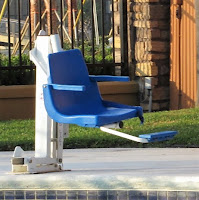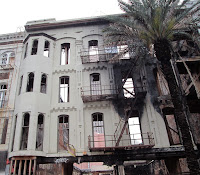Friday morning we hit the road and all was well. We spent the night in Slidell, LA and I had intended for our first stop to be New Orleans, however, in my usual ability to plan trips – that is a joke - I was without maps and had no idea how to find the French Quarter. Consequently, we – meaning me – managed to simply drive through New Orleans, missing the French Quarter all together. Who would have thought they would not have a sign on the interstate pointing out the direction to the French Quarter! Before I knew it, we were driving through Baton Rouge.Thought you might enjoy seeing the current capitol building and the old capitol building.


Between a morning rain shower and a marathon that was being run, streets and businesses were closed. We generally we were not impressed so decided we would just head west – toward Galveston, TX. Again, being the ingenious person that I am, and traveling without maps, I decided to take a road other than the interstate.
Driving along the Gulf of Mexico coastline we saw some interesting architecture. Debbie is now convinced I had lost my mind – if I ever had one – because I was taking pix left and right. It is a good thing there were very few other vehicles on the road we were on.
If you have never seen a library on stilts – don’t feel bad, neither had I. I also have no explanation as to how they handle handicap access. This caught my attention – warped as it is. The clearance for “book drops” is 9’6”.The was a gorgeous sculpture at the front of the library building.



The churches were also on stilts – as well as the police department and all the other government buildings.I do not know how they accommodate handicapped persons.Did you ever see a Catholic church with gargoyles?



Of course, I guess you have to appreciate the rationale of putting a double wide mobile home on stilts.How about a single-wide on stilts? These appeared to be raised at least 20’.Even the electrical service is on stilts.Whole subdivisions were built as what appeared to be year round homes and summer homes.




I could not guess why this farmer had all these porta- potties lined up across his yard.

That actually was sort of fun until we ran out or road. The road ended at a line of cars, boarding a ferry so we got in line with everyone else. The fellow directing the loading was really very nice, but didn’t quite know what to say when I asked where we were going.
When we got off the ferry we were greeted by a rather large billboard that “welcomed” us to Texas.
So far, two things were very clear to us and both things contradicted what should have been. Every town or city we had driven through was very hazy and it was extremely windy. It boggles the mind how it can be windy and still hazy. The beaches along the Gulf were certainly not inviting. The beaches were trashed and the water was rough and swelling. The Gulf Coast really should be named the “land of bridges” because we must have crossed over a 100 bridges, causeways and overpasses as we traveled through southern Louisiana and Texas.
One of many bridges and note how thick the haze is.You want to see pipeline, you should see all the pipe running above ground across Louisiana and Texas.


Again, as luck would have it, we ran out of road and ended in line to board another ferry. On the first ferry there were only about nine vehicles, but, on the second ferry there were probably, at least, 100 vehicles – and it was free and landed us in Galveston.
The background is as clear as it is going to get – that is haze you are seeing and the pipeline runs down the middle of the beach for literally miles.
The thing I love about Galveston is the architecture. If you want to see beautiful homes from the 1800s go there! But, the haze is overwhelming and the wind will beat you senseless.
This is a lift seat for a handicap person so they can get into the pool. This was installed at our hotel and the first I had seen such a device.I had to sneak this pix of a police officer from the University of Texas campus. The interesting thing is, all the way around her back and front waist, she has weapons of some type. There is no spot that was not used. Both her leg pockets were also full. Do you wonder what is happening on the UT campus?
There are tree sculptures scattered all over Galveston. We saw a few, but I kept getting distracted looking at the houses.

This is a Sacred Heart hospital.

Typical victorian architectural. This “social, or garden, club” was built in 1876 by a group of German businessmen. Only Germans or German speakers could hold stock in the club.




After Galveston we finally made it to San Antonio, where we did the Hop-On Hop-Off tour to gather an overview of the history of the area. Right off the bat the tour guide said something that confused me and I could not immediately reason out the facts. The guide said that the “Alamo” was not and never was a fort but was always a church. Well, the statement forced me to do a little research.
The Alamo and was founded in the 18th century as a Roman Catholic mission and fortress compound for the purpose of educating area American Indians after their conversion to Christianity.
The mission was secularized in 1793 and then abandoned.
Ten years later, it became a fortress housing the Second Flying Company of San Carlos de Parras military unit, who likely gave the mission the name Alamo. During the Texas Revolution, Mexican General Martin Perfecto de Cos surrendered the fort to the Texian Army in December 1835, following the Siege of Béxar. A relatively small number of Texian soldiers then occupied the compound for several months. They were wiped out at the Battle of the Alamo on March 6, 1836. When the Mexican army retreated from Texas several months later, they tore down many of the Alamo walls and burned some of the buildings.
So, by my research, I would say while it was not called “Fort Alamo”, it served as a fort and suffered through battles, therefore, it was a fort.


Welcome to the Buckhorn Restaurant and Museum where you can find over 500 different stuffed animals on display.

Apparently, the use of cell phones in the schools is not a problem.
The is a mural on the side of the Goodwill store across from the Market Square.
This is where the locals, and tourist, hang out - at “The Friendly Place”.
You can always take a carriage ride, but the gagas just don’t seem the perfect fit in “old town” San Antonio.
Of course we visited Riverwalk at ate at “Dick’s Last Resort”. I had eaten there before; the food was good, but not as good the second time around. You probably have to be a party animal and half soused to appreciate the atmosphere.
The Market Square hasn’t changed since I was there – it still has many beautiful items, but as with everywhere else, it is not all made locally or in Mexico.
Like Galveston you have to enjoy the architecture of San Antonio.


After San Antonio we headed back to New Orleans, determined not to miss a visit to the French Quarter.
We got a late start and had to wait out a thunderstorm, but finally made it to the French Quarter. After driving around for a while, or I should say sitting around in traffic, just absorbing the atmosphere, we finally made our way to the Welcome Center and joined the Hop-On Hop-Off tour so we could learn a little history.
New Orleans was founded in 1718 by Jean-Baptiste Le Moyne de Bienville. The city developed around a central square. That square, the oldest part of the city, became known as the French Quarter. The architecture is a mish mash of styles from the creole cottages, shotgun houses, and American town houses which have multi-levels built with brick or stucco and have a balcony. The Creole town houses are also built with brick or stucco, but have cast iron balconies and courtyards. The shotgun houses are only 12’ wide and one story. There are the double gallery (looks like a balcony, but is not called a balcony) – homes built with columns that supported the galleries and they have side gable roofs. The California bungalow was spread out rather than tall and has a concrete porch with a roof overhang. The construction styles were originally heavily influenced by the Spanish, Greek and French. By the 19th century the influence was American and French.
The Spanish influence was never strictly Spanish. It was Creole, which is a mixture of the French and Spanish with a dab of Carribbean for good measure.
Many buildings and homes have the cast iron and wrought iron railings and banisters.
Here are two samples of how they have painted scenes on their buildings.


Maintaining the architectural style, the facades are left intact and everything else is removed. The new construction is then attached to the old façade.
Want to know what is happening everyday at the Little Gem Saloon, just read the board posted outside the Saloon.
This is not a heavy traffic day – yeah right! Before the hurricane damage, we were told, 1.5M people lived in New Orleans; now only about 350,000. So, they say today, it is not crowded.
It is a festive past time to see who can land strings of necklaces in trees or on balconies.
Architectural styles


Bridge over the Mississippi River.
Here is an interesting fact for you. New Orleans has the oldest continuously operating street railway system in the world.
The warehouse district is not really warehouses any more. It is now the arts district and includes a new convention center that runs one mile in length.
The garden district is not a garden – it was named that because the homes each contained a garden.
We went by where the television program NCIS New Orleans is shot, as well as many other television programs and movies. There was a glimpse of where all the Mardi Gras floats are made and stored. I did see the new WWII museum and wish we had time to visit. The tour bus drove by the French Market and Flea Market but we opted to call it a day. We had seen all we wanted to see by that time.
Driving back through Mississippi the water was smooth as glass, the sun was shining, traffic was light, the homes along the Gulf Coast through Long Beach, Gulfport and Biloxi were breathtaking. There are still numerous vacant lots as a result of the hurricane damage, but the area is still a sight to behold.
Well, Debbie and I covered 2,350 miles during our eight day road trip to San Antonio. Now, it is good to be home.
That’s all for now - until next time.
















No comments:
Post a Comment